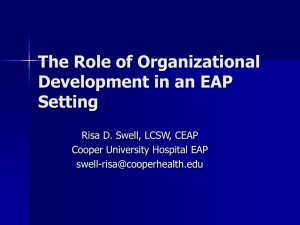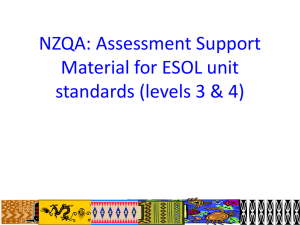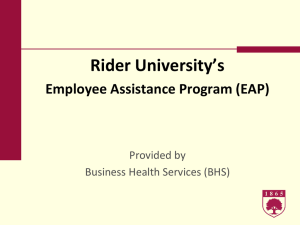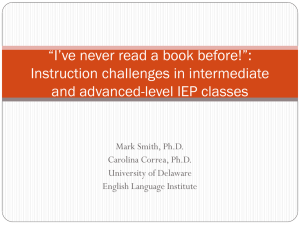EAP`s & Emergency Responses Ten Things You Need to Do
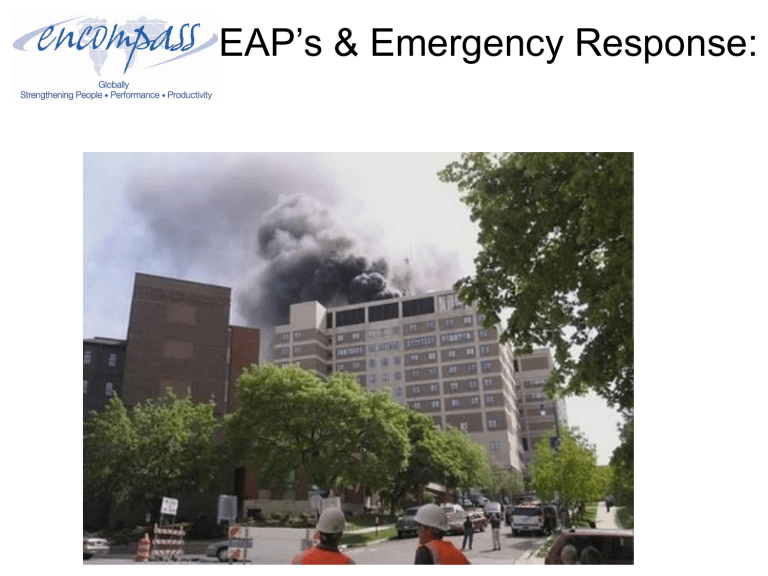
EAP’s & Emergency Response:
EAP’s & Emergency Response:
Ten Things You Need to Do
1. What Is an EAP?
2. Why Do EAPs Become Involved in
Crisis Management?
3. What Are the Ways That an EAP
May Help Your Company Before,
During and After a Crisis?
EAP’s & Emergency Response:
Ten Things You Need to Do
Q: What Is an EAP?
A:
many things…
EAP’s & Emergency Response:
Ten Things You Need to Do
Q: What Is an EAP?
• Family Issues
• Financial Problems
• Parenting Needs
• Confidential Consult
• Health & Wellness Support
EAP’s & Emergency Response:
Ten Things You Need to Do
Q: Why Do EAPs Become Involved in
Crisis Management?
A: Because people are impacted
PHYSCIALLY, EMOTIONALLY &
PSYCHOLOGICALLY…
EAP’s & Emergency Response:
Ten Things You Need to Do
Q: What Are the Ways That an EAP
May Help Your Company Before,
During and After a Crisis?
A: Prevention, Progress through a
Crisis EVENT and Debriefing following a Crisis or Traumatic
Event.
EAP’s & Emergency Response:
Ten Things You Need to Do
1)
Develop a Relationship with a Professional that
You TRUST
EAP’s & Emergency Response:
Ten Things You Need to Do
2) Understand & Anticipate a
Variety of NEEDS
• Equipment Fatality
• Car Accident
• Mental Health Issues
• Natural Disaster
• Domestic Violence
• Late to Work…
EAP’s & Emergency Response:
Ten Things You Need to Do
Crises impact various groups:
• People
• Families
• Community
EAP’s & Emergency Response:
Ten Things You Need to Do
3) Understand the Terminology:
Defusing
Debriefing
EAP’s & Emergency Response:
Ten Things You Need to Do
3) Understand the Terminology:
DEFUSING:
dee fy z ] a. make bomb harmless: to make a bomb or mine harmless by removing its detonating device b. ease difficult situation: to make a situation less tense, dangerous, or uncomfortable
EAP’s & Emergency Response:
Ten Things You Need to Do
3) Understand the Terminology:
Debriefing:
Debriefings originated in the military . This type of debriefing is used to receive information from a pilot or soldier after a mission, and to instruct the individual as to what information can be released to the public and what information is restricted.
EAP’s & Emergency Response:
Ten Things You Need to Do
3) Understand the Terminology:
Debriefing Term:
Critical Incident Stress Management
A debriefing is normally done within 72 hours of the incident and gives the individual or group he opportunity to talk about their experience, how it has affected them, brainstorm coping mechanisms, identify individuals at risk, and inform the individual or group about services available to them in their community.
EAP’s & Emergency Response:
Ten Things You Need to Do
4) A Crisis WILL occur
Readiness is crucial!
Tabletop drill.
EAP’s & Emergency Response:
Ten Things You Need to Do
5)
Have a list of Key Resources Clearly in
View – for ALL to respond
• Police/Sheriff
• Fire
• Emergency Response
• EAP
EAP’s & Emergency Response:
Ten Things You Need to Do
6) STORE Records & Other Essential
Information Off-Site
.
• Employment Records
• Insurance Information
Property
Casualty
Life/Health
• Computer Information & Records
EAP’s & Emergency Response:
Ten Things You Need to Do
7) Don’t Expect to Have All the Information or ‘Answers’
Most likely – when a crisis occurs, it is a rare company or person that knows exactly what is needed – let a trusted professional(s) assist you.
EAP’s & Emergency Response:
Ten Things You Need to Do
8)
Communication Plan and Designated
Key Communicator
• Media
• Technology
• Permission NOT to Talk
EAP’s & Emergency Response:
Ten Things You Need to Do
9) Pay Attention to WARNING Signs:
Different Behavior
Change in Attitude
Medical Change of Health Status
Ask questions
Offer Assistance
EAP’s & Emergency Response:
Ten Things You Need to Do
10) Be INTENTIONAL to Create A
“Culture of Safety”
People express concerns
People ask questions
People offer opinions
EAP’s & Emergency Response:
Ten Things You Need to Do
ENCOMPASS: 24/7
Crisis Management
Crisis Intervention
Critical Incident Stress
Management


